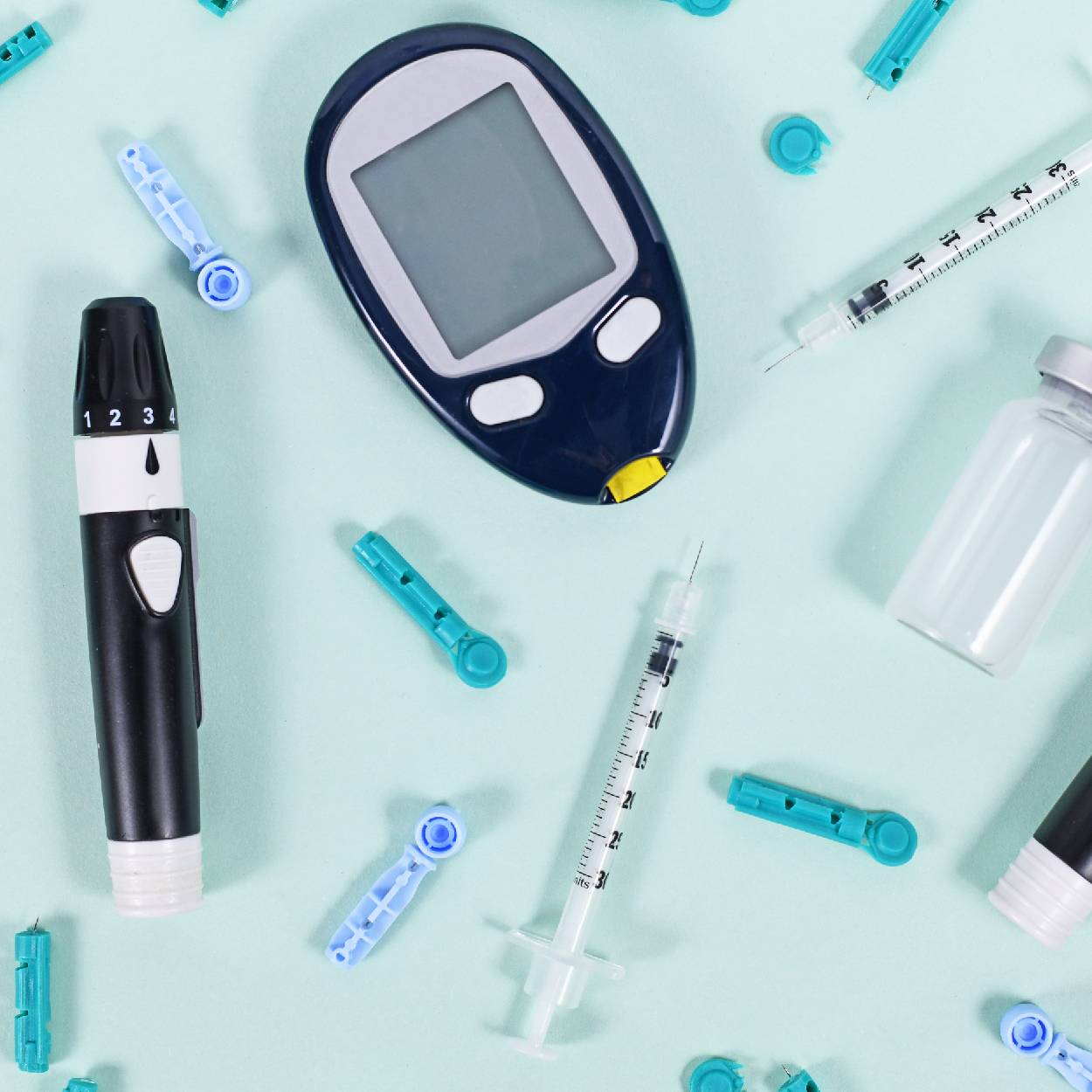A test that measures a person’s average blood glucose level over the past three months. Hemoglobin (HEE-mo-glo-bin) is the part of a red blood cell that carries oxygen to the cells. Also called hemoglobin A1C or glycosylated (gly-KOH-sih-lay-ted) hemoglobin, the test shows the amount of glucose that sticks to the red blood cell, which is proportional to the amount of glucose in the blood.
Understanding your A1C numbers
Testing and monitoring your blood glucose
How to use A1C to calculate estimated blood glucose
A1C and estimated average glucose (eAG)
Glucose to A1C Calculator: Convert Your Glucose Levels
Quick Reference Chart
| A1C | mg/dL | mmol/L |
|---|---|---|
| 4.0 | 50 | 2.6 |
| 5.0 | 80 | 4.7 |
| 6 | 115 | 6.3 |
| 7.0 | 150 | 8.2 |
| 8.0 | 180 | 10.0 |
| 9.0 | 215 | 11.9 |
| 10.0 | 250 | 13.7 |
| 11.0 | 280 | 15.6 |
| 12.0 | 315 | 17.4 |
| 13.0 | 350 | 19.3 |
| 14.0 | 380 | 21.1 |
Diabetes & A1C Explained
An important metric for diabetes management is your A1C. A1C is also known as hemoglobin A1C or HbA1c and it is one of the most commonly used tests to diagnose prediabetes and diabetes, as well as to monitor the management of diabetes. A1C is measured using a blood test to evaluate how much glucose has become attached to the hemoglobin in your red blood cells.
Knowing this value helps you and your doctor decide whether lifestyle changes such as a healthier diet to help manage blood glucose, increased physical activity, or any adjustments to your medication are needed. Understanding how to A1C relates to blood glucose readings is an important part of diabetes management.
A1C indicates your average blood sugar level over the past three month. It is reported as a percentage so understanding its value may be difficult when you are first diagnosed with pre-diabetes or diabetes. Using tools such as an A1C to glucose calculator can help you to better understand this number and get a sense of how your A1C percentage is dependent on how well you manage your blood sugar value on a day to day basis.
What is A1C?
The A1C test is a simple blood test that does not require fasting. It identifies your average blood glucose (blood sugar) levels over the previous three months based on the level of glycated hemoglobin. Hemoglobin is the protein in red blood cells that carries oxygen to organs and tissues and transports carbon dioxide back to our lungs. The life span of a red blood cell is about 120 days, and during the three months each blood cell is circulating, it is exposed to glucose which tends to attached to hemoglobin in a process called glycation. When blood glucose levels are higher more glucose sticks to the hemoglobin. The percentage of hemoglobin proteins that are glycated is reported by your A1C level. Having this checked at regular intervals can help you and your doctor to work together on a diabetes management strategy that works best for you.
It is common that at an annual physical your doctor will include an A1C test as part of your screening bloodwork, especially if you are exhibiting symptoms of diabetes like being overweight and are over age 45 (or earlier if you have other risk factors or considerations). While doctors may use different language when they talk about the A1C test — for example, glycated hemoglobin, hemoglobin A1C (HbA1c), or glycosylated hemoglobin — the test measures the same thing, namely the amount of sugar that has attached itself to your hemoglobin and is circulating through your body via your red blood cells.
Once diagnosed with pre-diabetes or diabetes, your doctor will be asking you to have blood tests regularly. Pre-diabetes is a warning that you need to pay more attention to your blood glucose level and implement lifestyle changes, like diet and exercise, to reduce your risk of developing diabetes. A1C test can become part of your treatment goals as it shows the cumulative effect of periods of high and low blood glucose levels. The goal is to keep your blood glucose in a healthy range as much of the time as possible. Dietary modification, medications, and regular testing or monitoring of you blood glucose will help you see the short term effects on your blood glucose level while your A1C value will provide the longer term average.
Understanding Your A1C Numbers
According to the Center for Disease Control a normal A1C is below 5.7 percent. An A1C level between 5.7 percent and 6.4 percent indicates pre-diabetes, which means that without interventions such as dietary changes or weight loss, you are at risk of developing diabetes. An A1C level of 6.5 percent or higher means your body has difficulty regulating your blood glucose level which puts you at increasing risk of diabetes complications and cardiovascular disease. Diet improvements have the greatest impact the sooner you start them. People with diabetes must make important lifestyle changes, may need to start taking medication to minimize disease risk.
Your A1C Value
| Normal | < 5.7% |
| Pre-diabetes | 5.7% – 6.4% |
| Diabetes | > 6.5%^ |
Blood Sugar Conversion to A1C: Testing and Monitoring your Blood Glucose
If you’ve been diagnosed with diabetes or pre-diabetes, your doctor may advise that you have your A1C tested every three months so that your diabetes management plan is continually optimized to meet your health needs. Part of your plan may be testing and monitoring your glucose levels at home using a blood glucose monitor. So learning how to calculate A1C from glucose readings is important to understand. You can use the estimated average glucose to A1C calculator found on this page to convert your blood glucose to A1C.
How to use A1C to calculate estimated Average Glucose (eAG)
Because A1C is directly related to the amount of glucose attached to your hemoglobin, using an A1C to glucose calculator can let you know the average blood glucose level you maintained in the previous three months. This value is reported as estimated Average Glucose (eAG) so it is easier to see the how it compares to your daily blood glucose measurements. It is important to note that daily monitoring of your blood glucose captures a moment in time, while your A1C/eAG reflect your average glucose levels. Effective diabetes management is about knowing your numbers.
The Centers for Disease Control has a reference chart available to see how your A1C level relates to a blood glucose level in mg/dl. For example, an A1C of 7 percent indicates and eAG (estimated average glucose) level of 150 mg/dL. Since 7 percent is greater than 6.5 percent, when your blood glucose is above 150 it signals that you are at risk for developing complications due to diabetes. If you can follow your diabetes management plan more closely or make improvement by talking with your doctor about adjustments to your diabetes management plan, you may be able to see you A1C percentage come down and have more blood glucose levels in your target range.
A1C Goals
To prevent complications from diabetes, your goal is to keep your A1C as low as possible, ideally < 7 percent. As your A1C value increases, so too does the amount of glucose in your hemoglobin. Higher levels of glucose circulating in your blood increases your risk for complications.
Everyone’s A1C goal may not be the same because your age and pre-existing medical conditions may influence your A1C. It is important to partner with your doctor to identify what your specific A1C goal is and how lifestyle changes such as a diabetic diet, increased physical activity, or medication can help you reach and maintain your A1C goal.
A1C and Estimated Average Glucose (eAG)
Since A1C looks at blood glucose for the past three months it can be helpful see how the daily ups and downs of blood glucose impacted your A1C. When this is calculated it is reported as eAG (estimated Average Glucose).
Depending on the report or type of glucose meter, blood glucose levels are expressed as mg/dl (milligrams per deciliter) or mmol/l (millimoles per liter). This chart shows the relationship between A1C and eAG (estimated Average Glucose). American Diabetes Association.
| A1C | eAG (estimated Average Glucose) | |
| % | Mg/dl | Mmol/l |
| 6 | 126 | 7.0 |
| 6.5 | 140 | 7.8 |
| 7 | 154 | 8.6 |
| 7.5 | 169 | 9.4 |
The American Diabetes Association (ADA) generally recommends the following target blood sugar levels: Between 80 and 130 milligrams per deciliter (mg/dL) or 4.4 to 7.2 milli-moles per liter (mmol/L) before meals; and less than 180 mg/dL (10.0 mmol/L) two hours after meals.
Time in Range
While understanding your A1C and eAG value in connection to how well your diabetes is being controlled is crucial, it is also important to know how much time you are in your target blood glucose range. This is known as time in range. Time in range should also be a metric used as part of your diabetes management plan.
If you use a Continuous Glucose Monitor (CGM) you may see information about your time with in your target blood glucose range. There may be a graph that shows the percentage of time your blood glucose was low, in range, or high. Keep in mind that your target blood glucose range may vary from someone else’s because of age and pre-existing medical conditions. As a result you will not want to compare your time in range to that of your friends or family members who may have different blood glucose target settings.
It is also important to remember that your time in range will be effected by many different factors including:
- Increased or decreased physical activity
- Food intake
- Stress
- Hormonal shifts
- Time of day
- What you’ve been eating
- Alcohol consumption
- Medications
How to Improve your A1C Levels
Lifestyle changes and compliance with medications can help you improve your A1C. Some lifestyle changes you can consider are:
A diabetic diet is a healthy diet and includes eating at regular intervals and following the guidance of a dietician or diabetes educator to plan ahead and know how to make
Some ideas for a healthy diet include increasing your daily intake of whole grains
–Nutritionally balanced meal replacements
A meal replacement will have a controlled serving size, 15 to 25g of protein and at least 20 percent of the daily value for essential vitamins and minerals. Meal replacements may be consumed as a liquid (in the form of a pudding shakes or other beverage) or discrete foods (like a protein bars, lite meal or high protein snack). They are often used in place of one or two daily meals (if 150-250 calories) or as a high protein snack (if <150 calories). Consult with your doctor, dietician or diabetes educator to create diet plan that will help keep your A1C at your target level.
When coupled with a healthy diabetic diet, aerobic exercise can help you use more calories to achieve a healthy body weight. When you have diabetes you need to know how monitor you blood glucose to meet your energy needs during exercise. Talk with your care provider to determine your exercise target glucose levels and when to test.Some good ways to get moving more are walking, swimming, dancing, yoga, Pilates or going for a hike. In addition to aerobic exercise, you can try resistance training. When paired with low calorie diets, resistance training and aerobic exercise can lead to weight loss. Maintaining a healthy weight can help keep your diabetes under control.
MANAGE STRESS
When you are feeling stressed, your body prepares itself to have enough glucose to release into your bloodstream, anticipating the need for fight or flight. The fight or flight response prompts our body to store extra glucose as fat. This can result in extended periods with elevated blood sugar, which in turn could negatively affect your A1C level. In addition to negative impacting your A1C level, stress can lead to making unhealthy food choices.
It is important to find ways to manage your stress by doing something physical like going for a walk, or doing regular mindfulness exercise like deep breathing, yoga, or making time to pursue activities or hobbies you enjoy. Be sure to talk with your doctor if you feel like you are having difficulty managing your stress on your own.
Be sure to get good quality sleep. The National Sleep Foundation recommends seven to nine hours of sleep per night. While quantity of sleep is important, the quality of sleep is also important because sleep quality is connected to emotional, mental, and physical well-being. Weight gain has been linked to poor quality, so getting good quality sleep can help you maintain your target A1C.Strategies to consider for improved sleep include going to bed and waking up at the same time each day, ensuring your bedroom is dark, quiet, and relaxing, keeping electronic devices out of the bedroom, and avoiding large meals and alcohol before bed.
MONITOR YOUR NUMBERS
Test your blood glucose daily or as directed by your doctor. Keep track of your numbers with an app or a journal. You can also track your blood glucose level or by using a blood glucose monitor, a device that can help you see how much of the time your blood glucose is in your target range to help you improve your A1C score.
Learning that you have pre-diabetes or diabetes can be scary and confusing, so it is important to follow your diabetes management plan. When you follow your plan, you can see the impact of your efforts with your next A1C blood tests and discuss your progress with regular visits or online calls with your health care provider. Remember, your A1C will vary depending on your daily activity level, stress, hormone shifts, food intake, or time of day and the more you time you range the more you can improve your A1C.
Be sure to keep track of our blood glucose and report any concerns to your doctor sooner rather than later. Use the glucose to a1c calculator to help you translate your A1C into your estimated average glucose. Your A1C is vital information that can help you work with your doctor to identify the optimal diabetes management plan for you. No matter what your numbers are, you should never be afraid to talk with your doctor about identifying your individual goals for managing your diabetes and living a healthy lifestyle.





